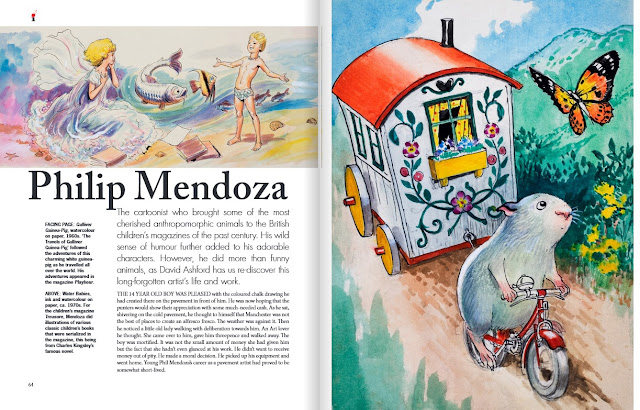The Summer issue of Illustrators has arrived with a trio of lengthy features, two recognisable names and a third that I'm happy to be introduced to.
David Ashford and Norman Wright lead off the issue with a piece on John Millar Watt a painter and comic strip artist with a unique look that is instantly recognisable. I was always surprised that Watt spent most of his pre-WW2 career drawing a cartoon strip, 'Pop', as my introduction to his work was via Look and Learn where he was chiefly a supplier of beautifully and intricately painted illustrations.
'Pop' was a rotund businessman, often the butt of jokes relating to his family life. The relatively simple linework of Pop's many misadventures disguises a complexity that was unusual for cartoons in the 1920s, Watt experimenting with the the panel structure and backgrounds to give the strip an illusion of a single image broken up into frames.
'Pop' was so popular that when Watt tried to leave the strip during the Second World War he was persuaded to keep going. Eventually he was able to quit in 1949, and turn to illustration and painting for the rest of his career, although during a downturn in the market in the late 1950s, he did draw a few issues of Thriller Picture Library. His association with Amalgamated Press's juvenile division led to him drawing extensively for their colour gravure papers, including Princess, Look and Learn and Ranger, including a gorgeously painted adaptation of Treasure Island reprinted by Bear Alley Books a couple of years ago.
Petar Meseldžija was unknown to me before this issue arrived. Thankfully, Diego Cardoba's article corrects that situation, with a detailed interview that spans the career of this Serbian fantasy artist, today living in Holland. Chiefly an illustrator of children's books, he broke through into the international market through the American publication of his The Legend of Steel Bashaw (based on a Serbian legend) in 2010.
David Ashford then looks at the works of Philip Mendoza, a firm favourite here at Bear Alley for many years. His early career as a political cartoonist after the Great War is covered, including some rarely seen early cartoons and advertising from the 1930s and the war years. In the post-War years, Mendoza churned out dozens of covers for paperbacks, from Hank Janson to the more upmarket Pan Books, before finding himself kept increasingly busy by the Amalgamated Press, drawing for Sun, Thriller Comics, Cowboy Comics and others.
In 1954, Amalgamated's Mike Butterworth tapped into Mendoza's talents as a fairy-tale artist with the launch of Playhour Pictures, and Mendoza remained associated with the nursery comic section for many years, drawing 'Gulliver Guinea Pig' (Playhour), 'Katie Country Mouse' (Harold Hare's Own) and illustrating many classic novels for Treasure and the 'Town Mouse and Country Mouse' tales in Once Upon a Time.
Mendoza's colourful art was matched only by his colourful character, his talents taking him from street artist to driving a Bentley. For the most part forgotten, it's nice to think that the article might reach a new generation of fans who will be able to appreciate his unique talents.
A brief gallery of work by Arthur Barbosa rounds out the issue.
For more information on Illustrators and back issues, visit the Book Palace website, where you can also find details of their online editions,
and news of upcoming issues. Issue 27 will have features on wild west artists Frederic Remington and Charles Schreyvogel.
Saturday, June 15, 2019
Subscribe to:
Post Comments (Atom)

























































No comments:
Post a Comment